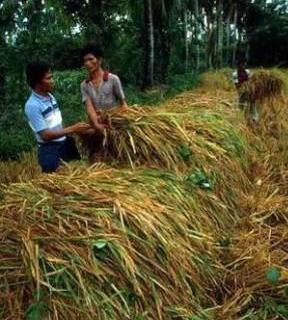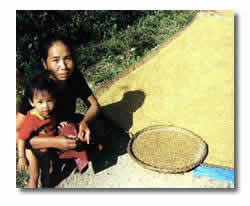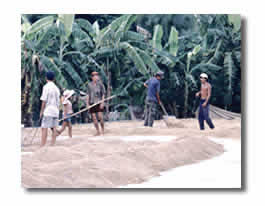|
|
|
|
|||||||
|
|
|
Post production: Drying |
|||||||
|
|
|
|
|
||||||
|
|
|
Sun drying |
|
||||||
|
|
|
|
|
||||||
|
|
|
Describe how to properly sun dry |
|||||||
|
|
|
|
|||||||
Dry with the help of the sun |
|
What is sun drying?
Sun drying is the traditional method for reducing the moisture content (MC) of paddy. With sun drying, the grains our spread out outside in the sun. The sun heats up the grains and also the surrounding air. This causes the water to evaporate from the grains, which makes the grain dry.
The warmth of the sun dries the grains
|
|||||||
Cheap and good for nature |
|
What are the benefits and limitations of sun drying?
|
|||||||
|
|
|
What are the sun drying methods? |
|||||||
Field drying should be avoided |
|
1. Field drying
|
Field drying often happens if the farmers needs to wait for the thresher. There is not enough air circulation to dry properly and at night the grain often gets wet again from the soil and the wet straw. This causes fast grain deterioration so it should be avoided.
In field drying the rice plants are often stacked in piles with the panicles inside to protect them from rain, birds and rats. Because of this, it becomes very, very hot inside the stacks.
|
||||||
Traditional, small-scale methods for individual farmers |
|
2. Panicle drying
|
The panicles are tied in bundles and placed on pavements or mats or hung from frames. There is uneven drying because the grains on the outside dry faster than the grains on the inside.
|
||||||
Medium-scale method for farmers, groups, and contractors. |
|
3. Drying on mats or canvas
|
This is the cleanest method. The grain can be easily mixed and quickly collected when dry. It asks for some small financial requirement as you need to buy the mat or canvas (plastic). |
||||||
|
|
|
4. Pavement drying
|
If you have a pavement you can do pavement drying. It is cheap but grain can easily mix with stones and dirt. You might need tools to mix the grain. |
||||||
Sun drying:Spread!Mix!Protect! |
|||||||||
|
|
|
|
|
||||||
|
|
|
Important: Monitor the drying process!
|
|||||||
|
|
|
||||||||
|
|
|
How to use an IRRI moisture meter?
Measuring the moisture content of the grain is very important to ensure proper drying. To measure moisture content you need to have a moisture meter. IRRI developed a cheap moisture meter that can be ordered at IRRI. If you would like to see a short video on how to use the IRRI moisture meter then click on the play button.
|
|||||||
Next lesson |
|
Let's have a look at mechanical drying systems. |
|||||||
|
|
|
|
|||||||

![obj[1]](obj_1_.gif)









